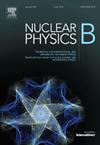Search for dark matter in the framework of Einstein-Cartan gravity at the International Linear Collider (ILC)
IF 2.5
3区 物理与天体物理
Q2 PHYSICS, PARTICLES & FIELDS
引用次数: 0
Abstract
This paper investigates the possibility of Dark Matter (DM) fermions production alongside a gauge boson (A′) using a model based on Einstein-Cartan gravity in an electron-positron linear collider, such as the ILC, that operates at a center-of-mass energy GeV with a detector's integrated luminosity of 500 fb−1. We used the WHIZARD package as the event generator to simulate the interactions that lead to the production of di-muon pairs and missing transverse energy. We specifically are performing this study on a low mass dark gauge boson, M= 10 GeV, that can subsequently decay into a muon pair (A while aiming to set upper limits on the free parameters' masses of the model, such as the torsion field (ST), if evidence for physics beyond the standard model is not found.
在国际线性对撞机(ILC)的爱因斯坦-卡坦引力框架下寻找暗物质
本文利用基于爱因斯坦-卡坦引力的模型,在一个正电子线性对撞机(如ILC)中研究了暗物质费米子与规范玻色子(a’)产生的可能性,该对撞机的质心能量为s=500 GeV,探测器的综合光度为500 fb−1。我们使用WHIZARD包作为事件生成器来模拟e+e -相互作用导致双介子对的产生和横向能量缺失。我们特别在低质量暗规范玻色子MA ‘ = 10 GeV上进行了这项研究,该玻色子随后可以衰变为μ子对(a→’ μ+μ−),同时旨在设置模型的自由参数质量的上限,例如扭转场(ST),如果没有找到超出标准模型的物理证据。
本文章由计算机程序翻译,如有差异,请以英文原文为准。
求助全文
约1分钟内获得全文
求助全文
来源期刊

Nuclear Physics B
物理-物理:粒子与场物理
CiteScore
5.50
自引率
7.10%
发文量
302
审稿时长
1 months
期刊介绍:
Nuclear Physics B focuses on the domain of high energy physics, quantum field theory, statistical systems, and mathematical physics, and includes four main sections: high energy physics - phenomenology, high energy physics - theory, high energy physics - experiment, and quantum field theory, statistical systems, and mathematical physics. The emphasis is on original research papers (Frontiers Articles or Full Length Articles), but Review Articles are also welcome.
 求助内容:
求助内容: 应助结果提醒方式:
应助结果提醒方式:


